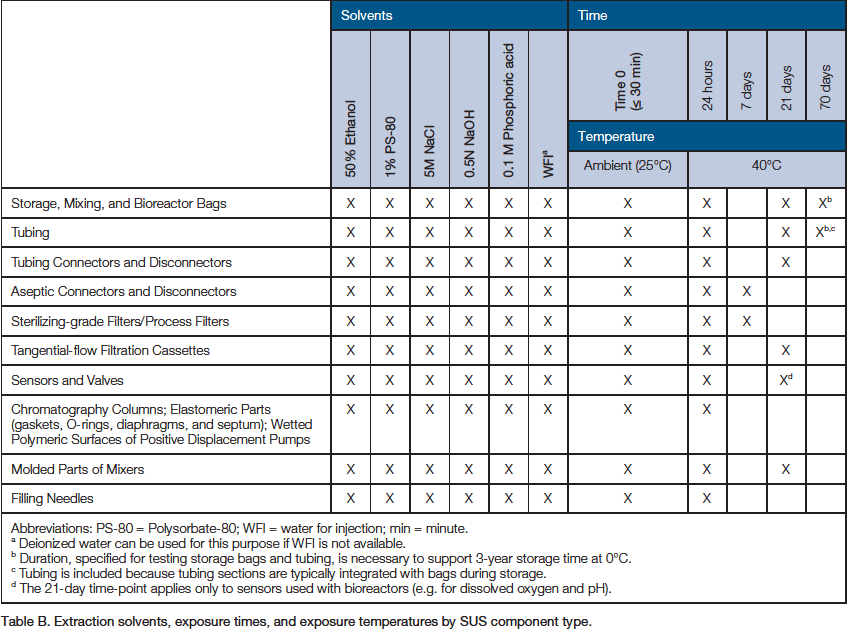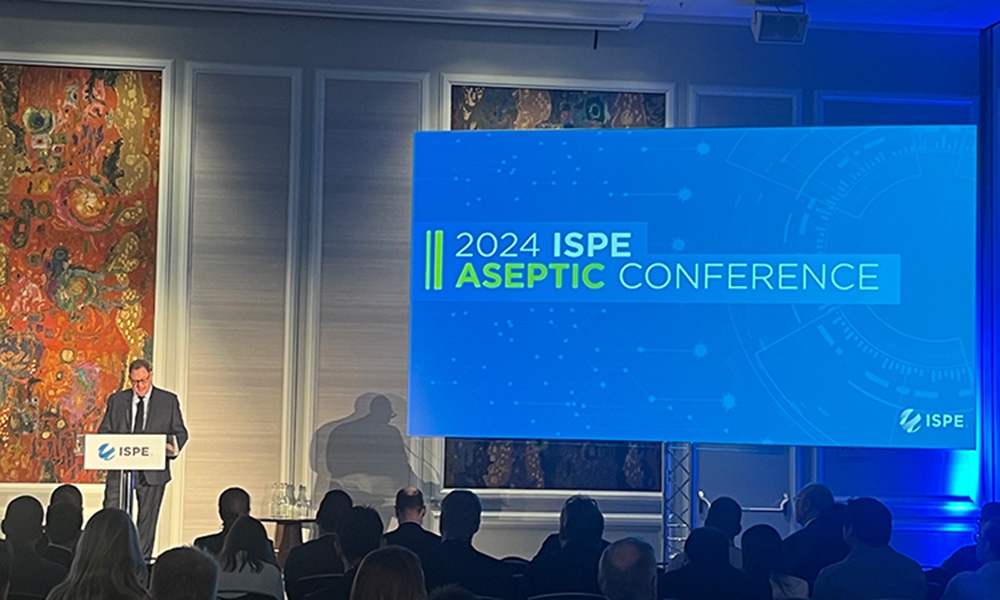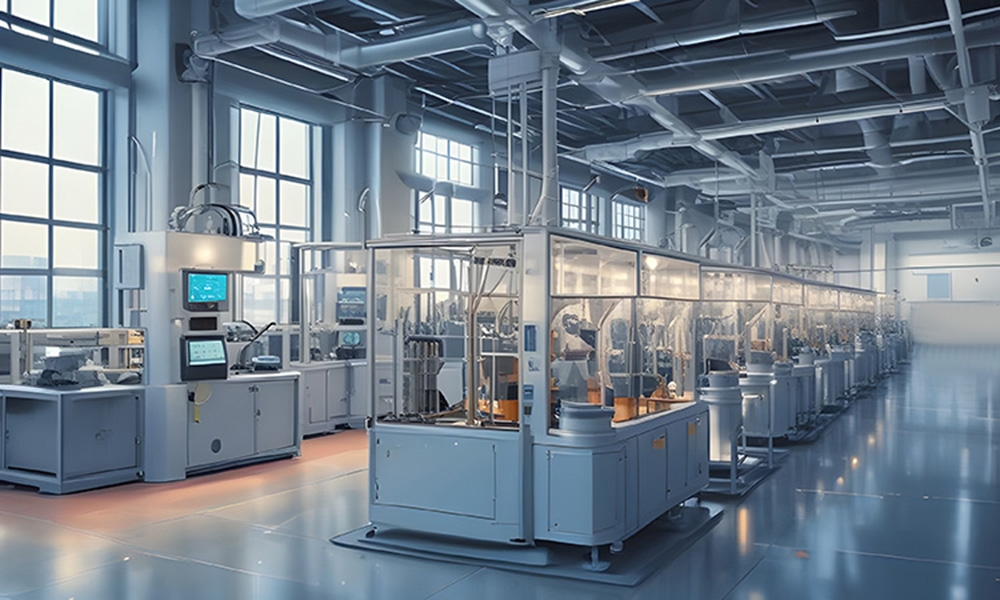Standardized Extractables Testing Protocol for Single-Use Systems in Biomanufacturing Part 3

This article presents a consensus standardized extractables testing protocol for single-use systems in biomanufacturing
This article was originally published in the November – December 2014 issue of Pharmaceutical Engineering® magazine. Click here for access to Part 1, Part 2, Part 4, and Part 5.
Choice of Extraction Solvents, Exposure Times, and Exposure Temperatures
Testing SUS components with the solvents, exposure times, and exposure temperatures listed in Table B will provide extractables data applicable to most biomanufacturing processes. Unique solvents and process conditions have been excluded. Solvents, exposure times, and exposure temperatures are recommended that represent reasonable worst-case conditions for most typical biomanufacturing applications. The initial time point at Time 0 (≤ 30 minutes) is based on well accepted analytical practices and sets a baseline for extraction kinetics evaluation. Studies have shown that the amount of some volatile extractable compounds decreased over time from Time 0 to 24 hours.2 It is also critical for cell viability assessment as volatile leachable compounds from bags come in direct contact with process fluid immediately which can impact cell culture processes.1 Protein stability can be impacted by change of pH or interaction of protein solutions with volatile and/or semivolatile leachable compounds on immediate contact. The 70-day data point specified for the storage bags and tubing is necessary to support long term storage of up to three years shelf life at 0°C storage condition. Tubing was included simply because tubing sections are typically integrated to the bag during storage. The combination of the temperature and time was established based on the ASTM F1980-07 Standard Guide for Accelerated Aging of Sterile Medical Devices.3

The common extraction model solvents included here comprise a broad range of buffer-based process fluids: water for injection (WFI), 0.1M phosphoric acid (low pH), and 0.5N NaOH (high pH). The choice of 50% ethanol was selected to represent organic solvents commonly used in bioprocesses such as aliphatic alcohols and glycols. Typical surfactant-containing aqueous solutions are represented by 1% polysorbate-80. Polysorbate-80, even at very low concentration, facilitates the leaching of small-molecule, aromatic compounds.25 The model solvent chosen to represent high salt concentrations in bioprocessing was 5M NaCl (high ionic strength). A review of available data packages and publications from SUS suppliers and end users indicated that certain chemicals observed in a NaCl extract were not detected in WFI extract.4 In other cases, the same extractables were observed in both NaCl and WFI extracts, but at significantly higher concentrations in the former. The six solvents also effectively simulate protein solutions which typically involve high pH, low pH, salt, WFI, organic compound and surfactant.
The base and acid recommendations cover most pH ranges in user operational conditions. When the recommended pH range is outside of the single-use component’s product claim due to chemical compatibility issue (e.g., polycarbonate-based aseptic connector is not compatible with 0.5N NaOH), the compatible pH range should be used for the testing and the justification should be stated in the summary extractables statement.
Acknowledgements
The authors sincerely thank the more than 40 colleagues from 18 companies in the BPOG Extractables Work Group for their contribution in developing our proposal, and in particular the following individuals: Tony White, Director BioPhorum Operations Group; Gerry McAuley, Facilitator BioPhorum Operations Group; Bobbijo V. Redler, Ph.D. Associate Principal Scientist Merck & Co., Inc.; Nancy Sweeney, Senior Scientist MTS Gallus Biopharmaceuticals; Ping Wang, Ph.D. Principal Scientist Johnson & Johnson; Russell Wong, PhD Sr. Manager Manufacturing Sciences – Raw Materials, Bayer Healthcare; Sally A. Kline, Scientific Director Amgen; Cara Weitzsacker, PhD QC Senior Specialist Bayer HealthCare; Amy J. Stitt, M.S. Scientist I Bristol-Myers Squibb; and Robert Repetto, Senior Director External Affairs Pfizer. The authors appreciate the detailed constructive review of the manuscript from Dr. Duncan Low from Amgen and Dr. Dennis Jenke from Baxter. We also thank Terry Hudson from Genentech, Dr. Michael T. Jones from Pfizer for reviewing the article, and Jim Sayer from Amgen for providing useful input on gamma irradiation.
- 2Joseph, W., E. Mahajan, and M. Shiratori, “Strategy for Selecting Disposable Bags for Cell Culture Media Applications Based on a Root-Cause Investigation,” Biotechnology Progress, Vol. 29, No. 6, 2013, pp. 1535-1549.
- 1Jenke, D.R., et al., “Accumulation of Organic Compounds Leached from Plastic Materials Used in Biopharmaceutical Process Containers,” PDA J Pharm Sci Technol, Vol. 61, No. 4, 2007, pp. 286-302.
- 3ASTM International, Standard Guide for Accelerated Aging of Sterile Barrier Systems for Medical Devices, 2011. http://www.astm.org/Standards/F1980.htm.
- 4Hong, J., “Extractable and Leachable Studies for Medical Devices Based on Blood Separation Technologies,” Extractables, Leachables & Elemental Impurities Forum, PharmaEd Resources, Inc., Philadelphia, PA, 2014.



